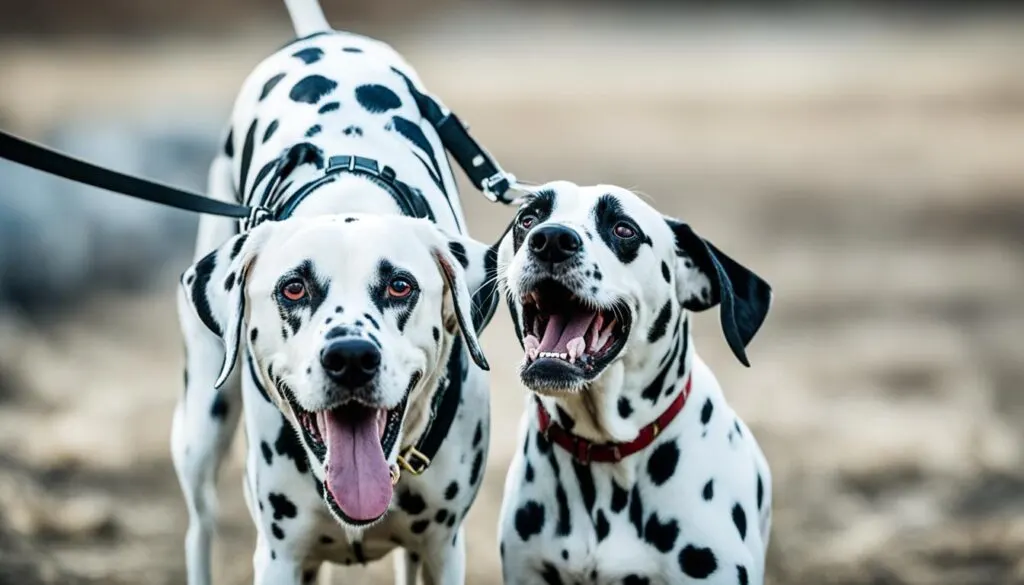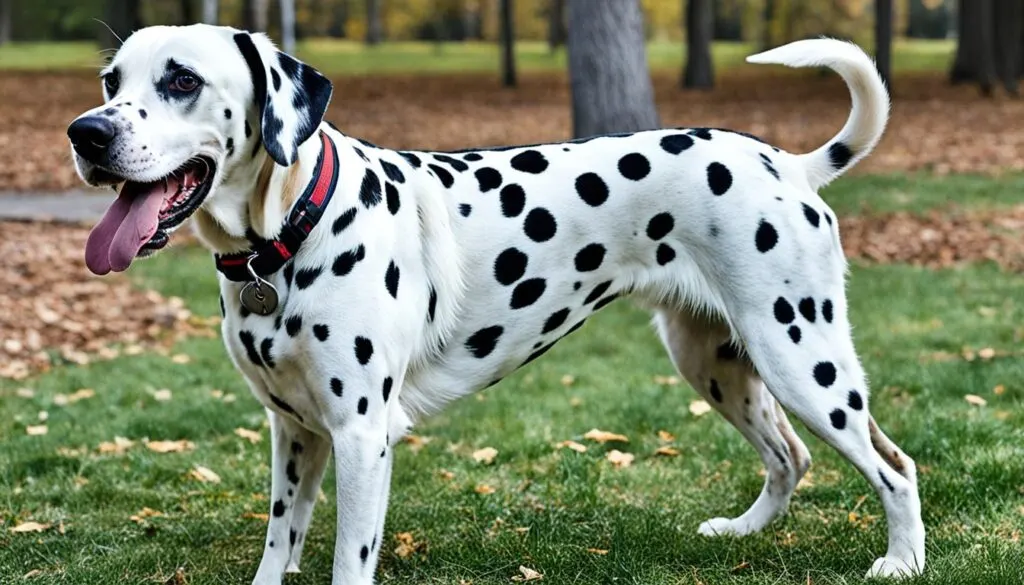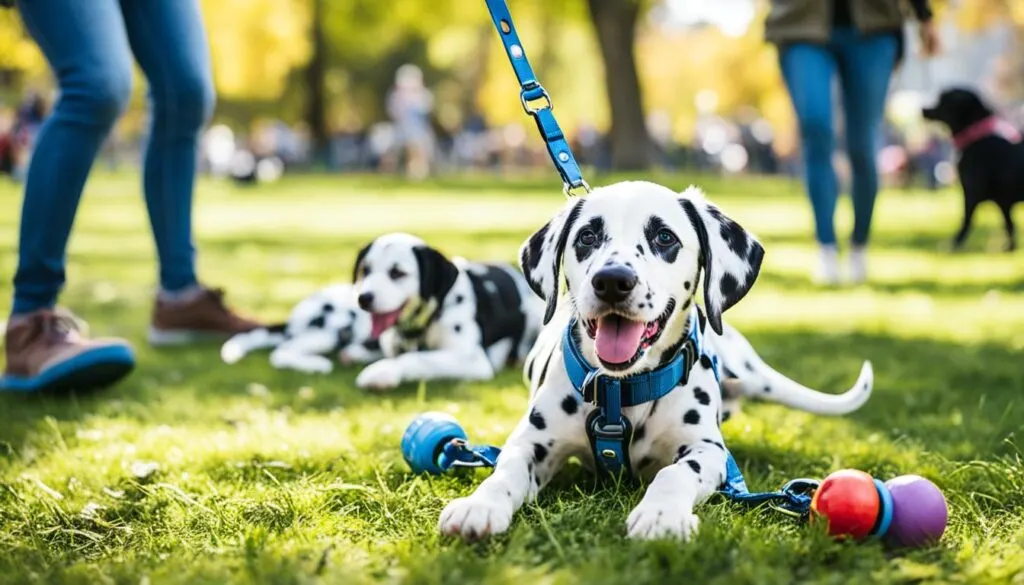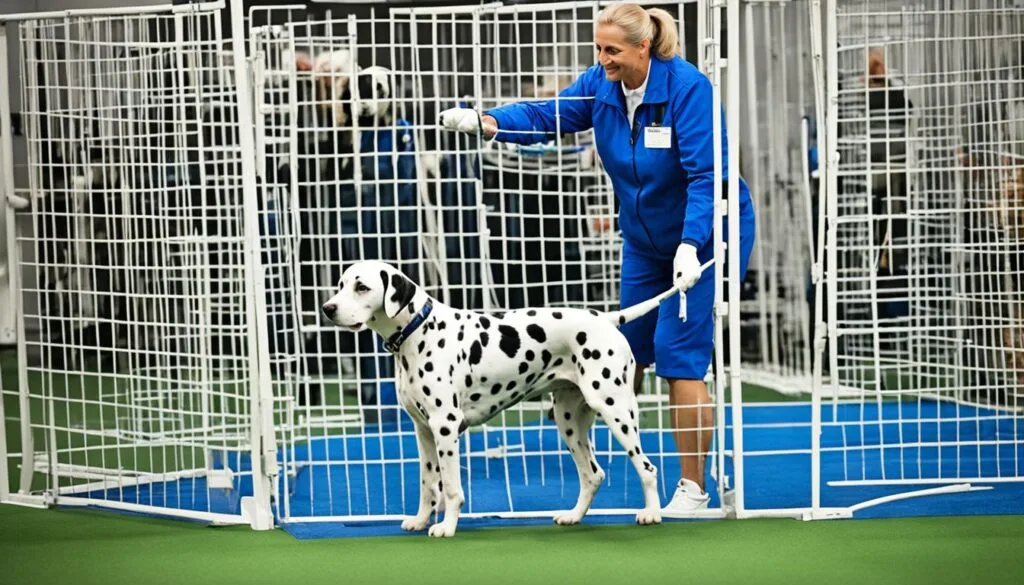Dalmatians are known for their distinctive black-and-white spotted coats and have a long history as working dogs.
While they are generally loyal and playful companions, their high-energy needs can have an impact on their behavior.
The question of whether Dalmatians are aggressive with other dogs is not a simple yes or no answer.
It depends on various factors such as their individual temperament, socialization, and training.
In this article, we will explore the different aspects that determine the aggression of Dalmatians towards other dogs and provide insights on how to prevent and manage aggression in this breed.

Click Here to Jump to a Section
Key Takeaways:
- Dalmatians have a long history as working dogs and are known for their distinctive coat.
- Their behavior towards other dogs can vary depending on individual factors.
- Temperament, socialization, and training play a significant role in determining aggression.
- Understanding their historical roles and needs can help in preventing and managing aggression.
- Proper training, socialization, and exercise are essential for a well-behaved Dalmatian.
Dalmatian Origins and Historical Roles
Dalmatians have a rich history that traces back to their origins in Dalmatia, a coastal area of Austria.
These distinctive dogs have played various roles throughout history, showcasing their loyalty and protective nature.
From Dalmatia to the Firehouse: A Storied Past
Originally, Dalmatians served as coach dogs, dutifully trotting alongside horse-drawn carriages to provide protection.
Their agility and alertness made them ideal companions for long journeys.
Over time, these spotted canines gained popularity as firehouse dogs.
They were admired for their ability to guard fire trucks and clear the way for the horses.
Dalmatians became an integral part of fire departments, symbolizing protection and loyalty.
The Spotted Coach Dog: A Symbol of Protection
The striking appearance of Dalmatians, with their unique black-and-white spotted coats, contributed to their reputation as symbols of protection.
Their presence alongside horse-drawn carriages and fire trucks conveyed a sense of security and safety.
With their strong instincts and natural guarding abilities, Dalmatians have proven themselves to be reliable and trustworthy companions throughout history.
Understanding the Dalmatian Temperament
Dalmatians are known for their unique black-and-white spotted coats and make loyal and playful companions.
They form strong bonds with their human family members and are generally good with other dogs and children.
However, it is important to understand their temperament and address their high-energy needs to prevent any potential behavioral issues.
Loyal and Playful Companions
Dalmatians are renowned for their loyalty.
They are deeply devoted to their owners and are always eager to please.
Their playful nature makes them excellent companions for families, particularly those with active lifestyles.
Dalmatians thrive on human interaction and love being part of the family dynamic.
High-Energy Needs: The Impact on Behavior
Dalmatians are energetic dogs that require plenty of exercise and mental stimulation.
Their high energy levels can have an impact on their behavior if not properly managed.
Without adequate outlets for their energy, Dalmatians can become bored, restless, and potentially prone to unwanted behaviors such as excessive barking, chewing, or even aggression.
Regular exercise is crucial for Dalmatians to maintain a balanced temperament.
Engaging them in activities such as long walks, jogging, or playing fetch can help burn off their excess energy and keep them physically and mentally stimulated.
Mental enrichment is also important, as Dalmatians are intelligent dogs that thrive on challenges and problem-solving tasks.
By providing Dalmatians with sufficient exercise and mental stimulation, their high-energy needs can be met in positive ways, reducing the risk of behavioral issues and ensuring a harmonious living environment for both the dog and the family.
With an understanding of the Dalmatian temperament and the fulfillment of their specific needs, they can be loving, well-behaved, and enjoyable companions for individuals and families alike.
Are Dalmatians Aggressive with Other Dogs?
One of the main concerns among dog owners is the reputation of Dalmatians for aggression towards other dogs.
However, it is important to note that not all Dalmatians display aggressive behavior towards other dogs.
Aggression is a complex behavior that can be influenced by various factors such as genetics, socialization, training, and individual temperament.
Each Dalmatian should be assessed individually to understand their behavior and determine appropriate training and socialization techniques.
While some Dalmatians may show signs of aggression, others may exhibit friendly and non-aggressive behavior towards other dogs.

Recognizing Aggression: Signs in Dalmatians and Other Breeds
Recognizing aggression in Dalmatians is crucial for preventing and managing aggressive behavior.
By understanding the common signs of aggression, dog owners can take appropriate measures to address and prevent aggression in Dalmatians and other breeds.
Common Behaviors Indicating Aggression
There are several behaviors that can indicate aggression in Dalmatians. These behaviors include:
- Snarling
- Nipping
- Growling
- Lunging
- Bared teeth
- Stiff body posture
When a Dalmatian displays any of these behaviors, it is essential to address the situation calmly and promptly to prevent escalation and potential harm.
Differentiating Between Playfulness and Aggression
It is important to differentiate between playfulness and aggression, as some behaviors may be mistaken for aggression when they are simply playful.
Playful behaviors in Dalmatians may include:
- Bowing
- Tail wagging
- Playful barking
- Engaging in play-fighting behavior without aggression
By observing the context and overall body language, owners can determine whether the behavior is playful or potentially aggressive.
Are Some Dalmatians More Prone to Aggression?
When it comes to aggression in Dalmatians, there are certain factors that can contribute to their behavior.
This section will explore two key aspects: the role of deafness and the effects of socialization on Dalmatian aggressiveness.
The Role of Deafness in Aggressive Behaviors
Deafness is a common condition in Dalmatians, with about 30% of them being either partially or completely deaf.
This can have an impact on their behavior, particularly when it comes to communication with their owners.
Communication problems can lead to fear-based aggression in deaf Dalmatians, as they may feel anxious or threatened in certain situations.
Socialization and Its Effects on Dalmatian Aggressiveness

Proper socialization plays a crucial role in preventing aggression in Dalmatians.
Socializing Dalmatians from an early age involves exposing them to different dogs, people, and environments in a positive and controlled manner.
This helps them develop positive behaviors and reduces the likelihood of aggression.
By ensuring that Dalmatians have positive experiences and interactions with various stimuli, they can become well-rounded and less prone to aggression.
Early and ongoing socialization is key to shaping their behavior and promoting a friendly and non-aggressive temperament.
Training and Socialization Tips to Prevent Aggression
Proper training and socialization are crucial in preventing aggression in Dalmatians.
It is important to use positive reinforcement techniques during training to promote desired behaviors and discourage aggression.
Positive reinforcement involves rewarding the dog for exhibiting good behavior, such as obeying commands or displaying calm behavior around other dogs.
The critical period for socialization in Dalmatians begins when they are puppies.
During this time, it is essential to expose them to different people, dogs, and situations in a positive and controlled manner.
This helps them develop positive associations and reactions, reducing the likelihood of aggression later in life.
When training and socializing your Dalmatian:
- Start early: Begin training and socialization as soon as you bring your Dalmatian puppy home. This allows them to learn and adapt at a young age.
- Be consistent: Consistency is key in training. Set clear rules and boundaries, and ensure that everyone in the household follows them.
- Use positive reinforcement: Reward your Dalmatian with treats, praise, or play whenever they exhibit desired behaviors. This helps reinforce the positive behaviors and motivates them to continue behaving well.
- Expose them to various environments: Take your Dalmatian to different places, such as parks, streets, and other dog-friendly areas. This helps them become comfortable and adaptable in different situations.
- Supervise interactions: When socializing your Dalmatian with other dogs, make sure the interactions are supervised and controlled. Gradually introduce them to new dogs, starting with calm, well-behaved ones, and monitor their behavior closely.
Exercise: A Key Factor in Dalmatian Temperament
Dalmatians are high-energy dogs that require plenty of exercise to maintain their temperament and prevent aggression.
It is important to provide both mental and physical stimulation to keep them happy and balanced.
The Need for Mental and Physical Stimulation
Dalmatians have a natural inclination towards energetic behavior, and without sufficient mental and physical stimulation, they may become bored and restless.
This can lead to unwanted behaviors, including aggression.
Physical exercise helps Dalmatians release pent-up energy and strengthens their physical well-being.
Regular walks, runs, or play sessions in a fenced yard can help tire them out and keep their bodies healthy.
However, mental stimulation is equally important for Dalmatians.
They are intelligent dogs that enjoy engaging activities that challenge their minds.
Puzzle toys, obedience training, and interactive games can provide the mental exercise they crave and prevent boredom-related behaviors.
Activities to Channel Energy Away from Aggression
To prevent aggression in Dalmatians, it is essential to channel their energy in positive ways.
Engaging them in activities that redirect their natural instincts can help prevent aggression and promote a balanced temperament.
Agility training is an excellent activity for Dalmatians.
It involves navigating obstacles, running through tunnels, and jumping over hurdles, providing both physical and mental stimulation.
This sport allows them to use their energy in a controlled and constructive manner.
Another activity that Dalmatians enjoy is obedience training.
This not only helps them learn essential commands but also challenges their mental capacities.
Training sessions provide opportunities for social interaction, mental focus, and bonding with their owners.
Additionally, incorporating structured playtime, such as fetch or hide-and-seek, allows Dalmatians to burn off excess energy while strengthening their bond with their human companions.
Providing regular exercise, both physical and mental, plays a vital role in maintaining a Dalmatian’s temperament and preventing aggression.
By fulfilling their need for stimulation and activity, Dalmatians can live fulfilling and well-rounded lives.
Selecting a Dalmatian: Breeder Responsibilities and Red Flags

When choosing a Dalmatian, it’s crucial to select a responsible breeder who prioritizes the health and temperament of their dogs.
A responsible breeder understands the importance of proper health screening and temperament testing to ensure that their Dalmatians are of the highest quality.
Choosing a Responsible Breeder
When searching for a Dalmatian breeder, it’s essential to consider certain factors that indicate responsible breeding practices.
A responsible breeder will:
- Provide thorough documentation, including health certificates and pedigrees
- Offer health guarantees and warranties
- Show genuine care for the well-being and future placement of their Dalmatians
- Be knowledgeable about the breed and its specific needs
- Allow potential owners to visit their facilities and meet the parent dogs
By choosing a responsible breeder, you can feel confident knowing that your Dalmatian has been bred with care and consideration for its health and temperament.
Health Screening and Temperament Testing
Responsible breeders prioritize the health of their Dalmatians by conducting thorough health screenings.
These screenings may include testing for conditions such as deafness, hip dysplasia, and certain genetic disorders that are more common in the breed.
By screening their breeding dogs, responsible breeders can help reduce the occurrence of these conditions in future litters.
In addition to health screening, temperament testing is crucial to ensure that Dalmatians have the right temperaments for their potential homes.
Temperament testing assesses a Dalmatian’s behavior, reactions, and overall temperament.
This helps breeders match each Dalmatian with the most suitable owner and environment.
By selecting a Dalmatian from a breeder who conducts health screening and temperament testing, you can have peace of mind knowing that the dog has been carefully assessed and is more likely to have a sound temperament and good overall health.
Dalmatians in the Home: Companionship and Family Dynamics
Dalmatians are not only beautiful dogs, but they can also make wonderful companions in the home.
However, it is important to understand their compatibility with children and other pets to ensure a harmonious and safe living environment.
Integration with Children and Other Pets
When introducing a Dalmatian into a home with children and other pets, it is crucial to take a gradual and controlled approach.
Start by allowing supervised interactions in a neutral space where everyone can feel comfortable.
This can help establish positive relationships and reduce the likelihood of any aggressive behavior.
It is important to teach children how to interact respectfully with dogs.
Show them how to approach a dog calmly and avoid behaviors that may provoke fear or aggression.
Educate them about the signs of stress or discomfort in dogs, such as a stiff body posture or bared teeth, and emphasize the importance of giving the dog space when it is needed.
Similarly, when integrating Dalmatians with other pets, proper introduction and supervision are essential.
Allow gradual interactions in a controlled environment, and observe their behavior closely to ensure that everyone feels safe and comfortable.
Training the Family: Teaching Children How to Interact with Dogs

Training Dalmatians is not only about teaching the dog; it also involves training the entire family.
Teach children the basic principles of positive reinforcement training and involve them in training sessions.
This can help them develop a deeper understanding of the dog’s behavior and promote a positive and cooperative relationship between the dog and the family.
It is important to set clear boundaries and rules for both the dog and the family members.
Consistency in enforcing these rules will help establish a structured and balanced household.
Furthermore, teaching children about responsible pet ownership, such as the importance of regular exercise, feeding schedules, and proper hygiene practices, can foster a sense of empathy and responsibility towards the dog.
Veterinary Care: Preventive Measures for a Healthy Life
Regular Vet Visits and Their Importance in Behavior Management
Regular veterinary care is crucial for ensuring a healthy life for Dalmatians and can play a vital role in behavior management.
By scheduling regular check-ups with a qualified veterinarian, you can stay proactive in maintaining your Dalmatian’s overall well-being.
These visits allow the veterinarian to monitor your dog’s health, identify any potential issues, and provide preventive measures to keep your Dalmatian in optimal condition.
During these check-ups, the veterinarian will conduct a thorough examination, including assessing your Dalmatian’s physical health, checking for any signs of illness or deficiencies, and evaluating their behavior.
Regular visits give the veterinarian an opportunity to observe any changes in your Dalmatian’s behavior, which can be indicative of underlying health issues or potential behavioral concerns.
Furthermore, veterinary professionals can provide guidance and advice on behavior management specific to Dalmatians.
They can offer recommendations on training techniques, behavioral modifications, and strategies to prevent or address any signs of aggression or other behavioral issues that may arise.
Dealing with Hereditary Health Issues That May Affect Behavior
Dalmatians are known to have certain hereditary health issues that can impact their behavior.
These issues may include conditions such as deafness and urinary problems.
It is important to be aware of these potential health concerns and take appropriate measures to address and manage them.
Regular veterinary care plays a pivotal role in managing hereditary health issues.
The veterinarian can provide guidance on proper care, offer treatments or medications if necessary, and help you develop strategies to mitigate any potential behavioral issues associated with these conditions.
By working closely with your veterinarian, you can ensure the well-being of your Dalmatian and take the necessary preventive measures to promote a healthy and balanced life.
Regular check-ups, along with addressing hereditary health issues, contribute to behavior management and enhance the overall quality of life for your beloved Dalmatian.
Dalmatian Popularity: The Impact of Media and Misconceptions
Dalmatian popularity has been greatly influenced by media portrayals, particularly the iconic movie “101 Dalmatians”.
This film, along with other media appearances, has played a significant role in increasing the popularity of Dalmatians as pets.
101 Dalmatians: A Double-Edged Sword of Popularity
The release of “101 Dalmatians” in 1961 sparked a surge in Dalmatian popularity, as viewers fell in love with the adorable puppies and their unique coats.
The film showcased the breed’s striking appearance and highlighted their role as lovable companions.
As a result, many families were inspired to bring Dalmatians into their homes, leading to a sharp increase in demand for the breed.
However, the movie did not provide a complete portrayal of the breed’s temperament and specific needs.
This led to misconceptions and unrealistic expectations among potential Dalmatian owners.
Many people were unaware of the breed’s high energy levels and the attention and exercise requirements that come with owning a Dalmatian.
Additionally, the sudden spike in demand led to irresponsible breeding practices by unscrupulous breeders looking to capitalize on the trend.
This resulted in numerous Dalmatians with health and behavioral issues, further reinforcing negative perceptions of the breed.
Navigating the Myths: Understanding the True Nature of Dalmatians
However, this popularity comes with its own set of challenges.
It is essential for potential Dalmatian owners to navigate through the myths and misconceptions surrounding the breed to make informed decisions.
While Dalmatians can make wonderful companions, it is important to understand their unique characteristics and the commitment required to meet their needs.
Dalmatians are known for their high energy levels and require regular exercise and mental stimulation.
Without proper outlets for their energy, they may exhibit destructive behavior or become anxious.
Potential owners must be prepared to provide the necessary exercise and activities to keep their Dalmatian happy and fulfilled.
Additionally, early and ongoing socialization is crucial for Dalmatians to develop good behaviors and positive interactions with other dogs and people.
Proper training and socialization can help prevent any potential aggression issues that may arise from their protective nature.
By dispelling the myths and understanding the true nature of Dalmatians, potential owners can make informed decisions and provide the best possible environment for these unique and loyal companions.
Advanced Training: Harnessing the Dalmatian’s Intelligence

Dalmatians are highly intelligent dogs that thrive when given the opportunity for advanced training and engaging in various sports and activities.
These activities not only provide mental stimulation but also help channel their abundant energy in a positive way.
Specifically tailored for energetic breeds like the Dalmatian, advanced training can lead to a well-rounded and obedient companion.
Sports and Activities Tailored for Energetic Breeds
For Dalmatians, participating in sports and activities that cater to their high energy levels is key.
One popular option is agility training, where Dalmatians can showcase their speed, agility, and problem-solving abilities.
This fast-paced sport involves navigating through obstacle courses, which stimulates both their physical and mental prowess.
Additionally, obedience training is another valuable activity for Dalmatians, as it helps them develop discipline, focus, and a strong bond with their owner.
The Benefits of Agility and Obedience Training
Engaging in agility and obedience training has numerous benefits for Dalmatians.
Firstly, it provides them with an outlet for their energy, which can reduce the likelihood of negative behaviors resulting from pent-up energy.
These activities also boost their confidence and self-esteem, as they overcome challenges and master new skills.
Furthermore, participating in agility and obedience training strengthens the bond between Dalmatians and their owners.
The trust built during training sessions fosters a deeper connection and enhances communication between them.
This strong bond is crucial for effective training and can positively influence their overall behavior and temperament.
In conclusion, advanced training, particularly agility and obedience training, is a fantastic way to harness the intelligence and energy of Dalmatians.
These activities provide mental and physical stimulation, enhance obedience, and strengthen the bond between Dalmatians and their owners.
When properly trained and engaged, Dalmatians can thrive and showcase their exceptional abilities in various sports and activities.
